| Listing 1 - 10 of 17 | << page >> |
Sort by
|
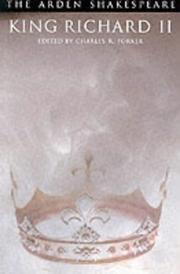
ISBN: 9781903436332 1903436338 190343632X Year: 2002 Publisher: London: Arden Shakespeare,
Abstract | Keywords | Export | Availability | Bookmark
 Loading...
Loading...Choose an application
- Reference Manager
- EndNote
- RefWorks (Direct export to RefWorks)
Book
ISBN: 9781857095838 Year: 2015 Publisher: London National Gallery
Abstract | Keywords | Export | Availability | Bookmark
 Loading...
Loading...Choose an application
- Reference Manager
- EndNote
- RefWorks (Direct export to RefWorks)
Painting --- Wilton Diptych --- painting [image-making] --- Richard II [King of England] --- National Gallery [London]
Book
ISBN: 9780719038532 9780719038525 0719038537 0719038529 Year: 2012 Volume: *12 Publisher: Manchester ; New York Manchester University Press
Abstract | Keywords | Export | Availability | Bookmark
 Loading...
Loading...Choose an application
- Reference Manager
- EndNote
- RefWorks (Direct export to RefWorks)
Great Britain --- Grande-Bretagne --- History --- Sources. --- Histoire --- Sources --- Richard II (roi d'Angleterre ; 1367-1400)
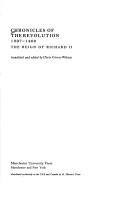
ISBN: 0719035279 Year: 1993 Volume: *2 Publisher: Manchester, UK New York New York Manchester University Press Distributed exclusively in the USA and Canada by St. Martin's Press
Abstract | Keywords | Export | Availability | Bookmark
 Loading...
Loading...Choose an application
- Reference Manager
- EndNote
- RefWorks (Direct export to RefWorks)

ISBN: 0300070039 0300149050 Year: 1997 Publisher: New Haven ; London Yale University Press
Abstract | Keywords | Export | Availability | Bookmark
 Loading...
Loading...Choose an application
- Reference Manager
- EndNote
- RefWorks (Direct export to RefWorks)
Richard --- Richard the Redeless, --- Great Britain --- History --- Kings and rulers --- Henry IV, 1399-1413 --- Biography --- Richard II --- Civilization [Medieval ] --- 14th century --- Richard - II, - King of England, - 1367-1400. --- Biography. --- RICHARD II, ROI D'ANGLETERRE, 1367-1400 --- ANGLETERRE --- BIOGRAPHIES --- HISTOIRE --- 14E SIECLE
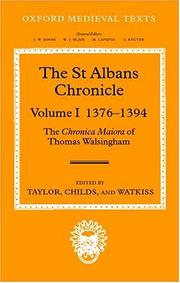
ISBN: 019820471X 9780199253463 9780198204718 0199253463 Year: 2011 Publisher: Oxford: Clarendon,
Abstract | Keywords | Export | Availability | Bookmark
 Loading...
Loading...Choose an application
- Reference Manager
- EndNote
- RefWorks (Direct export to RefWorks)
Thomas Walsingham, a monk of St Albans, has been described as the last of the great medieval chroniclers. His major work, the Chronica maiora, covers the years 1376-1422, and is arguably the most important account of English history to be written in England at this time. Walsingham's text has never been published as a continuous whole. It is found in no fewer than three separate publications in the Rolls Series, and was printed from manuscripts whose exact identity was not then clearly understood. The nature of the Rolls Series publications, and the different versions of the chronicle have raised questions concerning the relationship of the various manuscripts of the Chronica maiora, and also of Walsingham's own involvement with the text. In this new edition these problems are considered and the Chronica maiora is shown to be predominantly the work of one man, Thomas Walsingham. Volume I of The St Albans Chronicle (1376-1394) contains that part of Walsingham's chronicle which can with some confidence be said to have been written by 1400. With the exception of a brief contemporary continuation (1393-4) the text is taken from BL MS Royal 13 E IX which, although known to the Rolls Series editors, was not used by them as a principal source. During the 1390s the Royal manuscript was extensively revised at St Albans in order to remove criticisms of John of Gaunt. This revision is perhaps the best example of the contemporary rewriting of history in late medieval England. Although Walsingham has traditionally been regarded as the chronicler of the Lancastrian revolution, this part of his chronicle reveals his work as a major source for the Peasants' Revolt, the emergence of John Wyclif, and the political struggles of Richard II's reign. In everything that he wrote, Walsingham was as much a commentator as a recorder, and his absorbing chronicle reveals the manner in which one interested contemporary viewed current events. Volume II of the St Albans Chronicle (1394-1422) now completes the edition. Drawing on the text in Bodley 462 and confirming the work of V. H. Galbraith, the editors make clear that the Annales Ricardi Secundi et Henrici Quarti (regarded in the Rolls Series as a separate chronicle) were an integral part of the Chronica maiora. They also argue that, while Walsingham's contribution as author in the later years was much smaller than in the years to 1393 (when he was without doubt the sole author), it is most likely that he supervised the whole work; and at times, as in the vivid and dramatic descriptions of the battles of Shrewsbury and of Agincourt, his own style is again apparent. The chronicle is of the greatest historical value for Richard II's last years and for his deposition and the accession of Henry IV. It is wholly in favour of the Lancastrian revolution of 1399 and remains 'Lancastrian' in tone to its end. It illustrates (with sympathy) Henry's difficulties in establishing the dynasty and includes unique material on his relations with his son. For Henry V's reign it provides valuable details of his Norman campaigns. Over both reigns St Albans' hatred of Lollardy and its interest in the healing of the Great Schism are apparent in the coverage given them. In the later years, the extent of the commentary on events decreases, but the information available at St Albans and written here continues to be of a high order. The chronicle remains absorbing right to its end.
Great Britain --- Grande-Bretagne --- History --- Sources --- Histoire --- Walsingham, Thomas, --- Henri V, 1413-1422 --- Henry IV, 1399-1413 --- Richard II, 1377-1399 --- Walsingham, Thomas --- Walsingham, Thomas, - fl. 1360-1420. - Chronica Maiora --- Great Britain - History - Henry IV, 1399-1413 - Sources --- Great Britain - History - Henry V, 1413-1422 - Sources --- Great Britain - History - Richard II, 1377-1399 --- 1377-1399 (Richard II) --- Ouvrages avant 1800 --- 1399-1413 (Henri IV) --- 1413-1422 (Henri V)
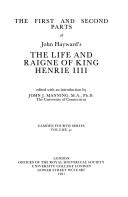
ISBN: 0861931297 9780861931293 Year: 1991 Volume: 42 Publisher: London: Offices of the Royal historical society,
Abstract | Keywords | Export | Availability | Bookmark
 Loading...
Loading...Choose an application
- Reference Manager
- EndNote
- RefWorks (Direct export to RefWorks)
Henry --- Richard --- Great Britain --- Grande-Bretagne --- History --- Histoire --- Henry IV, King of England --- -History --- -Henry IV, King of England --- -Henry --- Henry, --- הנרי הרביעי --- Richard II, 1377-1399 --- Richard II --- Henry IV, 1399-1413 --- Henry - IV, - King of England, - 1367-1413. --- Great Britain - History - Henry IV, 1399-1413. --- Grande-bretagne --- Henri iv, roi d'angleterre, 1367-1413 --- 1399-1413 (henri iv) --- Biographie
Book
ISBN: 0816605955 9780816605958 Year: 1971 Publisher: Minneapolis: University of Minnesota press,
Abstract | Keywords | Export | Availability | Bookmark
 Loading...
Loading...Choose an application
- Reference Manager
- EndNote
- RefWorks (Direct export to RefWorks)
Shakespeare, William, --- Criticism and interpretation --- Andronicus, Titus (Legendary character) --- Drama --- Technique --- Richard --- In literature --- Technique. --- Shakespeare, William --- Criticism and interpretation. --- In literature. --- Andronicus, Titus (Legendary character). --- Drama - Technique --- Shakespeare, William, - 1564-1616 - Criticism and interpretation --- Richard - II, - King of England, - 1367-1400 - In literature --- Shakespeare, William, - 1564-1616 --- Richard - II, - King of England, - 1367-1400
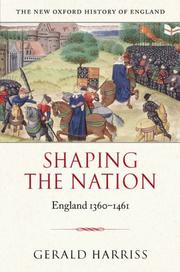
ISBN: 9780198228165 0198228163 0199211191 9780199211197 Year: 2005 Publisher: Oxford: Oxford university press,
Abstract | Keywords | Export | Availability | Bookmark
 Loading...
Loading...Choose an application
- Reference Manager
- EndNote
- RefWorks (Direct export to RefWorks)
Great Britain --- England --- Grande-Bretagne --- Angleterre --- History --- Civilization --- Histoire --- Civilisation --- Lancaster (House of) --- Edward III, 1327-1377 --- Richard II, 1377-1399 --- 1066-1485 --- Angleterre (GB) --- 1327-1377 (Édouard III) --- 1377-1399 (Richard II) --- 1399-1413 (Henri IV) --- 1413-1422 (Henri V) --- 1422-1461 (Henri VI) --- 1360-1461
Book
ISBN: 9782753503724 2753503729 2753527121 2821818300 9782753527126 9782821818309 Year: 2007 Volume: *5 Publisher: Presses universitaires de Rennes
Abstract | Keywords | Export | Availability | Bookmark
 Loading...
Loading...Choose an application
- Reference Manager
- EndNote
- RefWorks (Direct export to RefWorks)
King Richard II, pièce historique qui ouvre la seconde tétralogie de Shakespeare, est joué pour la première fois en 1595, par la troupe « The Chamberlain’s Men », sans doute dans le théâtre de James Burbage. Si la pièce a attiré de nombreux metteurs en scène britanniques depuis l’époque élisabéthaine jusqu’à nos jours, ce n’est qu’en 1947 qu’elle a été représentée en France sous la direction de Jean Vilar à Avignon - dans ces deux pays, cependant, les représentations de King Richard II se sont multipliées depuis. Les diverses études et entretiens de cet ouvrage permettent de jeter un éclairage sur les mises en scène anglaises et françaises de la seconde moitié du XXe siècle jusqu’à la production récente de Trevor Nunn à l’Old Vic Theatre, à Londres (2005). Riche d’une rhétorique étincelante, d’un langage qui n’en finit pas de se mettre en scène, de métaphores optiques dont la célèbre anamorphose de Bushy, King Richard II se prête particulièrement à des jeux de mises en perspective. Ainsi sont également étudiés les rapports complexes du pentamètre iambique originel et de la traduction en français, du texte et de la scène, du texte et de l’image, de la métaphore et de sa littéralisation visuelle, de la littérarité textuelle et de ses prolongements imaginaires. Mettant en regard articles, entretiens et table ronde, cet ouvrage propose d’aborder la pièce historique de Shakespeare sous l’angle double de la mise en scène et de la mise en perspective, avec les contributions de Jean-Michel Déprats, Paul Desveaux, Pascale Drouet, Michael Earley, Cécile Falcon, Carole Guidicelli, Wilhelmina L. Hotchkiss, François Laroque, Edouard Lekston, Marie-Madeleine Martinet, Nathalie Rivère de Caries, Estelle Rivier, Isabelle Schwartz-Gastine, Clotilde Thouret et Kate Wilkinson.
Shakespeare, William --- Shakespeare, William, --- Criticism and interpretation --- Shakespeare, William, - 1564-1616 --- Shakespeare, William, - 1564-1616. - King Richard II --- English --- Languages & Literatures --- English Literature --- mise en scène --- dramaturgie --- adaptation --- théâtre
| Listing 1 - 10 of 17 | << page >> |
Sort by
|

 Search
Search Feedback
Feedback About UniCat
About UniCat  Help
Help News
News